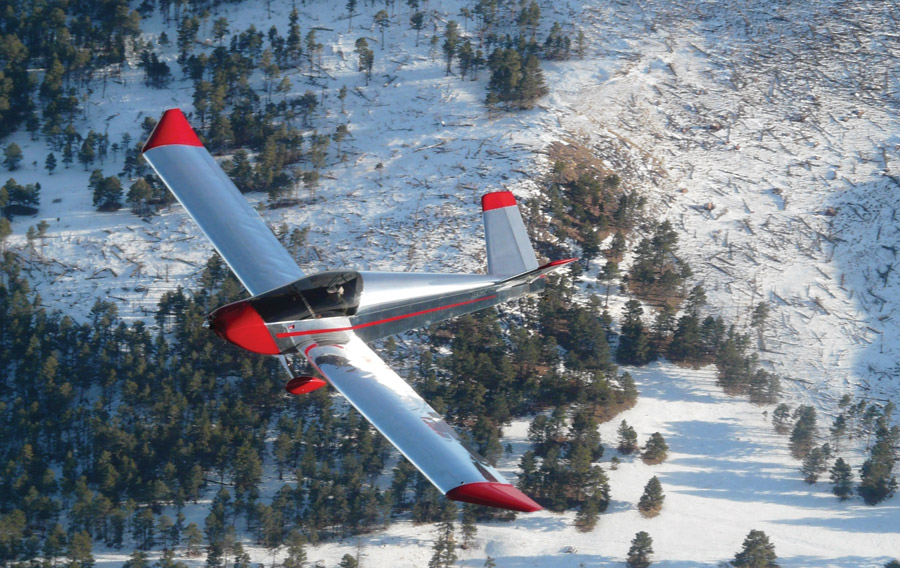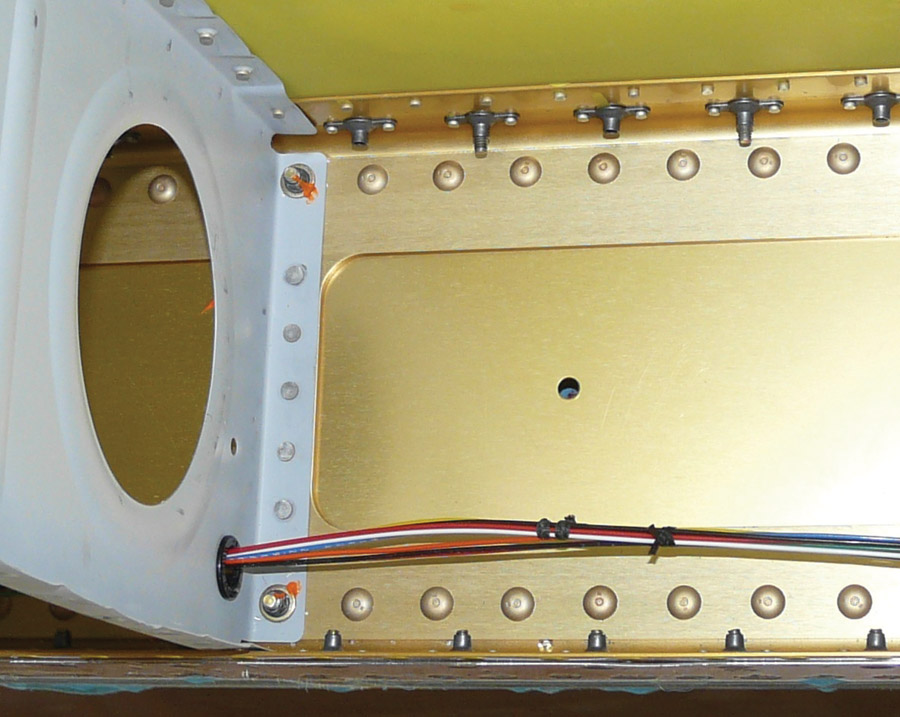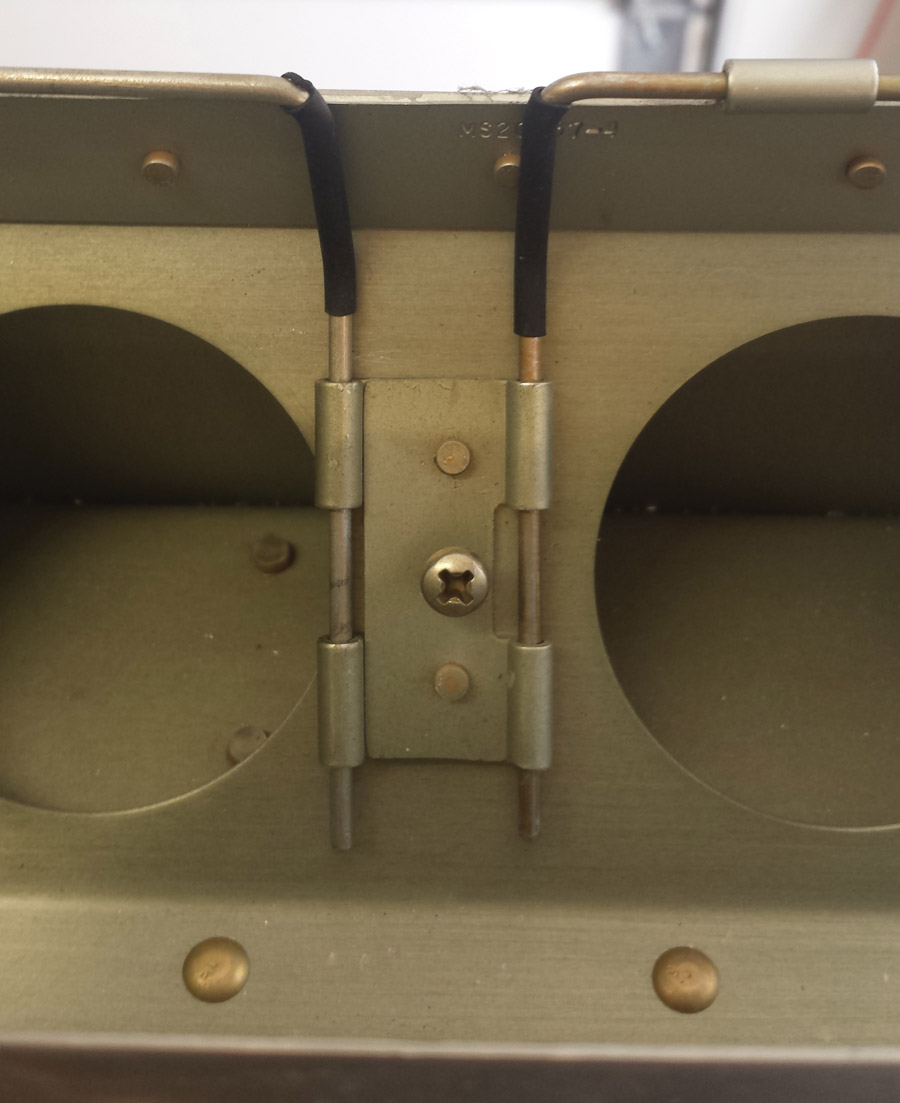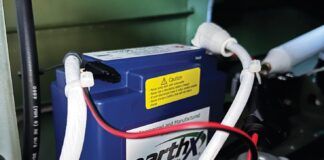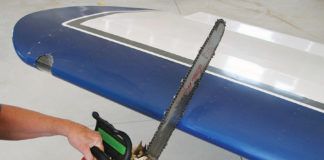Dave Dooley flies his Xenos motorglider near the Colorado foothills. The minimal paint saves weight and is a good accent to the polished aluminum. (Photo: Nancy Clair)
I started writing this, thinking this is going to be pretty simple. This is KITPLANES magazine, and if it’s a kit aircraft, well, don’t save weight on structure if the designer doesn’t tell you to. Of course, that still leaves a lot of options available to write about.
If you’re the designer, for structural parts, don’t try to save a lot of weight in the fittings. They’ve got to transfer some load, and they last longer if they’re robust. The place to save weight is in the continuous members, things like spars or tail cones. The fittings don’t have to be crude, though; keep in mind the load paths and design so that the fittings don’t have a lot of areas that don’t contribute to distributing the load.
But if you’re the builder—and this is important, only if the designer agrees—don’t neglect buckling because buckling is such an important part of airplane design. Remember, in some places, stiffness is very important and the parts might be designed for that rather than strength. If you’re the designer, make sure that there’s still a positive margin of safety for all the load cases with the lighter design.
With that out of the way, here are some suggestions.
Measuring Weight
I use grams. Each pound has 453.6 of them, and most common kitchen scales can read in either pounds and ounces or grams. Set it to grams. I feel that, depending on the effort, it’s probably not worth spending much time on something that’s under three grams for the whole plane unless it’s easy and inexpensive. Anything more than that and I’ll probably at least consider it. Ten grams and I’ll take it seriously. One hundred grams and it’s definitely worth going after. It’s the cumulative effect on the whole airplane that counts, not how much a single one weighs.
Nuts
The MS21042 all-metal locking nut supersedes AN363, AN364, AN365, MS20364, MS20365, MS21040, some NAS679, and a few other less common nuts. How do we know that the MS21042 nuts supersede the older AN nuts? The MS21042 specification says so. The older AN365 fiber or nylon locknuts are very common in general aviation, and the MS21042 nuts are lighter. It’s always worth checking the specification if you’re using hardware that’s new to you.
Better yet, they’re smaller, and in some cases that’ll let you use a shorter bolt for additional weight savings. It’s a few grams here and there that really add up. I bought enough of the MS21042 to replace all the AN365 nuts on my RV-3B, and even though this is a small airplane, it’ll save me about one pound right there.
Washers
The washers we generally use come in two main thicknesses. If you can use the thinner one, that’ll save you a little weight. If it’ll let you get by with a shorter bolt or screw, especially using those lightweight nuts, even better. On my RV-3B, I try every bolted joint to see how light I can get it and still maintain the appropriate bolt grip. Remember that the bolt grip length is often at least as important as the threads and might prevent using a lighter bolt.
Corners
Sometimes we need square corners, especially on the external parts of the airplane like skins. But we usually don’t on the interior corners. Rounding the corners while maintaining appropriate edge distance will save you a little weight. Probably not a lot, probably under a half pound, depending on your airplane, but that’s certainly worth going after, and it’s a good habit to get into.
Webs
Sometimes a part is built like a spar, with caps and a web. Or it might even be a spar. Perhaps it’s some sort of rib or bulkhead or something. Generally speaking, the center third of the part pretty much can only carry axial or shear forces, and lightening holes might be appropriate. I say might, rather than saying to go ahead with them, because they might not. Often the kit plans will tell you where you can drill them out but sometimes they won’t. With these, it’s important to have an idea of the loads because holes make a web less resistant to buckling. You know the rule: ask first. If it’s your design, do the shear analysis and see.
If there’s a stiffened bead around a center flat disk, the interior, that disk, can almost always be drilled out—the bead itself provides the needed buckling resistance. Even so, if it’s not in the plans, check.
Bolts and Screws
Mixing bolts or screws in a fastener pattern along with driven rivets is a no-no if the fasteners are in shear. What happens is that the driven rivets fill the hole and will start to fail before the bolt or screw gets properly loaded up. Then the bolts or screws are left carrying the load with the rivets having failed or partly failed. But this isn’t always the case: On my RV-3B, there are some wing rib to spar joints where the shear load is carried by the driven rivets and the moment load from the flap is carried into the spar by loading bolts in tension. For that sort of situation, it works. It works because the bolts are torqued and that causes a preload, which acts in tension as effectively as a driven rivet does in shear.
So if you see such a joint, be sure you understand how it works. It’s probably not a great place to try to save some weight.
The rib-to-spar joint uses both bolts and rivets, acceptable here. The nuts are the lightweight MS21042. On the bottom row of screws, I’ve already changed the -inch long screws that the plans call for to 3/8-inch long screws. On the top, I’ll do that after I move the wing and that side becomes accessible. Note that I’m using lacing instead of zip ties on the wire.
Small Details
Pesky little details that are left to the builder can be good places to save weight. A friend made the nifty hinge pin retaining fitting shown in the photo below. While it doesn’t weigh much all by itself, it provides a handy example of places where you can save a little weight. They add up. Here’s the weight-savings aspect of it: You only need one hinge loop per hinge pin end, not two, and there don’t need to be any rivets. You’d only save four grams, but it’s a good example of how to save weight in some details.
Actually, you don’t need any hinge pieces or screws—drill two small holes in the sheet metal that’s in front of the assembly, and tie some safety wire through them around the two pins. There’s access through the lightening holes to loop the wire back through the second small hole. That’ll probably let you save up to six or eight grams. You’ll eliminate the hidden nutplate, too.
The moral here is to ask yourself if a particular part is needed and how else that function can be acquired. I like to have at least three alternatives, all with different concepts, before choosing any of them.
Speaking of small details, do you need conduit or can plastic bushings suffice? The bushings are a bit more awkward, but definitely lighter.
Are you using zip-ties or lacing? The lacing is slightly lighter and won’t snag your hand later. The good old EA-AC 43.13-1A & 2A shows how to tie the knots.
There might be canopy options that you are considering. Thinner is lighter. It’s also more frangible if you need to break it apart to get out of the airplane. You’ll have to decide if that’s balanced by lower resistance to a bird strike or something else.
Composite Parts
There are lots of nonstructural and semi-structural parts made of fiberglass on most of our airplanes, and we often get to make some more. Generally speaking, if you use carbon fiber instead of glass for the layup, you’ll increase the stiffness and save about 20% of the weight, maybe more. But of course if you’re making a composite airplane, don’t go indiscriminately replacing glass with carbon in structural parts. You can only do this for things like fairings, wheel pants and so on. Don’t modify the primary structure unless you’re the designer and know the engineering characteristics of the particular materials you’re working with.
Even so, carbon has a much lower coefficient of thermal expansion than fiberglass, so you need to account for that. It also reacts with adjacent metals, causing them to corrode, so that, too, needs your attention. That weight savings does add up, though.
If you learn how to vacuum bag your composite parts, you’ll save some weight and get a better layup, too.
Glue
Perhaps it’s small potatoes, but with glue squeeze-out along edges of bonded parts, it’s generally much better structurally to make a smooth but small fillet than keep a round bead. The fillet is usually lighter, too. This might come under the category of good workmanship instead of weight savings, but as it does save weight, I’ll take it.
Fabric
If your airplane has fabric, you can check the various fabric vendors to see what the lightest fabric is for the type of airplane you’re building. The fabric might depend on the gross weight, the wing loading, the speed or something else. Perhaps a new fabric like Oratex might be suitable and lighter than the standard fabric. You might need to call the vendor to get a good idea of how much a particular system weighs if their website doesn’t supply it. Be sure to assess the weight of the coating system as well as the fabric itself.
Electronics
Some of the electronics we add are essentially modular in nature, interconnected with wire bundles. The best way to save weight is not to install anything more than the minimum that you need for the operations you intend to fly. Do you really need an autopilot? Or a second or third EFIS screen? If you can eliminate an entire subsystem, you also remove the power and ground connections and the circuit breaker and fuse. Maybe you’ll get lucky and leave off a switch, too.
Sometimes you can locate some of the modules quite close to each other and that reduces the length of the wire bundle. Or if you read the installation manuals, you might find that a competitor has more integration and fewer pieces—count the cables. Occasionally we might have a choice between a panel-mounted device and a similar device that has a panel-mounted control head and a remote box; remember that the version that’s entirely mounted in the panel not only doesn’t have that wire bundle, it doesn’t have the connectors. But there’s a trade-off you’ll need to assess between that and the possibly longer antenna cable, if there is one.
On smaller details, if you can run a continuous wire instead of using a connector, you might be better off. It may save some weight, even if you allow some extra wire for a future connector to be installed, and you’ll remove a possible joint that can be intermittent. The time alone that you could save would justify it, and in the future, if you need to, you can usually still insert a connection. This idea is for places where the pieces of airplane aren’t usually removed. An example might be the wing-to-fuselage joint. Another might be the control stick.
These days, there are some lighter batteries available that were probably unavailable when the plane was designed. Be sure you understand the safety aspects of them if you’re going to use them. And bear in mind the effect that change will have on your center of gravity. Nonetheless, you might be able to save more than 10 pounds there.
Paint
Ah, paint. There are so many different paints that you can use! I don’t know much about paint, and I’ve never painted an airplane. All I can suggest is that it’s possible to make the paint job either lighter or heavier. I’ve seen paint weight estimates vary from five pounds to 30 pounds for a typical homebuilt. Some paint is discretionary. If you have an aluminum airplane and you polish it, that’ll save some serious weight.
A lot of people use filler under their paint jobs. That should be used sparingly if at all, and only the lightweight fillers at that.
These days, wraps are becoming popular. How does their weight compare?
Since composite parts almost always need some paint; you can polish the metal and paint those parts like Dave Dooley did on his pretty Xenos motorglider on page 44.
An airplane has a total surface area that’s something like three to five times the wing area. Since polymers weigh something like .05 pounds per cubic inch, you can quickly make a very rough estimate of the weight of paint if you can get an idea of how thick the total coating buildup will be. For example, if there’s 600 square feet and the cured coating thickness is .005 inches, the paint adds roughly 21 or 22 pounds. Didn’t think I’d let you get this far without some math, did you?
Here’s a useful factoid: A “mil” is a measure of thickness. One mil equals .001 inches. Some coating companies use that in their manuals.
Firewall Forward
This area offers some interesting options for major weight savings. I’ve heard that the narrow-deck Lycomings might be around 20 pounds lighter than the later models, for example, and accessories like starters can vary from under seven pounds to over 13, and some of the “lightweight” starters are grossly misnamed. Likewise, don’t install a larger alternator than you need.
Other things like oil filter mounts come in a variety of forms and some of them even need hoses. Others don’t. Prop governors also vary in weight.
If you can avoid a constant-speed prop, you might save some serious weight there, since that also eliminates the governor and its control, as well as a lot of prop weight. For Lycomings, that might get rid of an external oil line, too.
Some of the aftermarket suppliers offer some very lightweight equipment, often things like sumps or intake manifolds. They might be worth considering.
Some airplanes are sensitive to engine installation weight for center of gravity reasons. If you’re planning to save lots of weight up front or wherever your engine is, keep this in mind and plan to move other equipment around to adjust the center of gravity position if needed.


